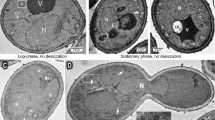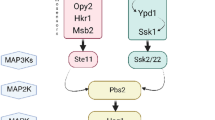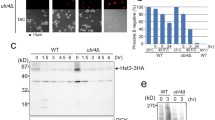Abstract
Two Saccharomyces cerevisiae strains, BY4741 and BY4741-derived strain lacking the IST2 gene (ist2Δ), were used to characterise the possible role of cortical endoplasmic reticulum (ER) protein Ist2 upon cell dehydration and subsequent rehydration. For the first time, we show that not only protein components of the plasma membrane (PM), but also at least one ER membrane protein (Ist2) play an important role in the maintenance of the viability of yeast cells during dehydration and subsequent rehydration. The low viability of the mutant strain ist2∆ upon dehydration-rehydration stress was related to the lack of Ist2 protein in the ER. We revealed that the PM of ist2∆ strain is not able to completely restore its molecular organisation during reactivation from the state of anhydrobiosis. As the result, the permeability of the PM remains high regardless of the type of reactivation (rapid or gradual rehydration). We conclude that ER protein Ist2 plays an important role in ensuring the stability of molecular organisation and functionality of the PM during dehydration-rehydration stress. These results indicate an important role of ER-PM interactions during cells transition into the state of anhydrobiosis and the subsequent restoration of their physiological activities.


Similar content being viewed by others
Data availability
All data generated during this study are included in this paper.
References
Beker MJ, Rapoport AI (1987) Conservation of yeast by dehydration. Adv Biochem Eng Biotechnol 35:127–171
Beker MJ, Blumbergs JE, Ventina EJ, Rapoport AI (1984) Characteristics of celluar membranes at rehydration of dehydrated yeast Saccharomyces cerevisiae. Appl Microbiol Biotehnol 19:347–352
Bernauer L, Radkohl A, Lehmayer LGK, Emmerstorfer-Augustin A (2021) Komagataella phaffii as emerging model organism in fundamental research. Front Microbiol 11:607028
Borovikova D, Herynkova P, Rapoport A, Sychrova H (2014) Potassium uptake system Trk2 is crucial for yeast cell viability during anhydrobiosis. FEMS Microbiol Lett 350:28–33
Borovikova D, Teparic R, Mrsa V, Rapoport A (2016) Anhydrobiosis in yeast: cell wall mannoproteins are important for yeast Saccharomyces cerevisiae resistance to dehydration. Yeast 33:347–353
Calahan D, Dunham M, DeSevo C, Koshland DE (2011) Genetic analysis of desiccation tolerance in Saccharomyces cerevisiae. Genetics 189:507–519
Camara AA Jr, Sant’ Ana AS (2021) Advances in yeast preservation: physiological aspects for cell perpetuation. Curr Opin Food Sci 38:62–70
Chang CL, Chen YJ, Liou J (2017) ER-plasma membrane junctions: why and how do we study them? BBA Mol Cell Res 1864:1494–1506
Choudhary V, Schneiter R (2020) Lipid droplet biogenesis from specialized ER subdomains. Microbial Cell 7:218–221
Choudhary V, El Atab O, Mizzon G, Prinz WA, Schneiter R (2020) Seipin and Nem1 establish discrete ER subdomains to initiate yeast lipid droplet biogenesis. J Cell Biol 219:e201910177
Clegg JS (2001) Cryptobiosis–a peculiar state of biological organization. Comp Biochem Physiol Part B 128:613–624
Crowe JH, Crowe LM, Carpenter JF, Wistrom CA (1987) Stabilization of dry phospholipid bilayers and proteins by sugars. Biochem J 242:1–10
Crowe JH, Hoekstra FA, Crowe LM (1989) Membrane phase transitions are responsible for imbibitional damage in dry pollen. PNAS 86:520–523
Crowe JH, Oliver AE, Tablin F (2002) Is there a single biochemical adaptation to anhydrobiosis. Integr Comp Biol 42:497–503
Dupont S, Beney L, Ritt JF, Lherminier J, Gervais P (2010) Lateral reorganization of plasma membrane is involved in the yeast resistance to severe dehydration. Biochim Biophys Acta 1798:975–985
Dupont S, Rapoport A, Gervais P, Beney L (2014) The survival kit of Saccharomyces cerevisiae for anhydrobiosis. Appl Microbiol Biotechnol 98:8821–8834
Duskova M, Borovikova D, Herynkova P, Rapoport A, Sychrova H (2015) The role of glycerol transporters in yeast cells in various physiological and stress conditions. FEMS Microbiol Lett 362:1–8
Fischer MA, Temmerman K, Ercan E, Nickel W, Seedorf M (2009) Binding of plasma membrane lipids recruits the yeast integral membrane protein Ist2 to the cortical ER. Traffic 10:1084–1097
Grube M, Gavare M, Rozenfelde L, Rapoport A (2014) Anhydrobiosis in yeast: FT-IR spectroscopic studies of yeast grown under conditions of severe oxygen limitation. Biotechnol Appl Biochem 61:474–479
Guzhova I, Krallish I, Khroustalyova G, Margulis B, Rapoport A (2008) Dehydration of yeast: changes in the intracellular content of Hsp 70 family proteins. Proc Biochem 43:1138–1141
Hansen KG, Aviram N, Laborenz J, Bibi C, Meyer M, Spang A, Schuldiner M, Herrmann JM (2018) An ER surface retrieval pathway safeguards the import of mitochondrial membrane proteins in yeast. Science 361:1118–1122
Hijazi I, Knupp J, Chang A (2020) Retrograde signaling mediates an adaptive survival response to endoplasmic reticulum stress in Saccharomyces cerevisiae. J Cell Sci 133:jcs241539
Kaufman RJ, Malhotra JD (2014) Calcium trafficking integrates endoplasmic reticulum function with mitochondrial bioenergetics. Biochim Biophys Acta 1843:2233–2239
Kawazoe N, Kimata Y, Izawa S (2017) Acetic acid causes endoplasmic reticulum stress and induces the unfolded protein response in Saccharomyces cerevisiae. Front Microbiol 8:1192
Knupp J, Arvan P, Chang A (2019) Increased mitochondrial respiration promotes survival from endoplasmic reticulum stress. Cell Death Differ 26:487–501
Kralt A, Carreta M, Mari M, Reggiori F, Steen A, Poolman B, Veenhoff LM (2014) Intrinsically disordered linker and plasma membrane-binding motif sort Ist2 and Ssy1 to junctions. Traffic 16:135–147
Ktistakis NT (2020) ER platforms mediating autophagosome generation. BBA Mol Cell Biol Lipids 1865:158433
Kulikova-Borovikova D, Lisi S, Dauss E, Alamae T, Buzzini P, Hallsworth JE, Rapoport A (2018) Activity of the α-glucoside transporter Agt1 in Saccharomyces cerevisiae cells during dehydration-rehydration events. Fungal Biol 122:613–620
Le QG, Ishiwata-Kimata Y, Kohno K, Kimata Y (2016) Cadmium impairs protein folding in the endoplasmic reticulum and induces the unfolded protein response. FEMS Yeast Res 16:049
Leslie SB, Teter SA, Crowe LM, Crowe JH (1994) Trehalose lowers membrane phase transitions in dry yeast cells. Biochim Biophys Acta 1192:7–13
Manford AG, Stefan CJ, Yuan HL, MacGrun JA, Emr SD (2012) ER-to-plasma membrane tethering proteins regulate cell signaling and ER morphology. Dev Cell 23:1129–1140
Miyagawa K-I, Ishiwata-Kimata Y, Kohno K, Kimata Y (2014) Ethanol stress impairs protein folding in the endoplasmic reticulum and activates Ire1 in Saccharomyces cerevisiae. Biosci Biotechnol Biochem 78:1389–1391
Nakatogawa H (2020) Autophagic degradation of the endoplasmic reticulum. Proc Jpn Acad Ser B 96:1–9
Nakatsukasa K (2021) Potential physiological relevance of ERAD to the biosynthesis of GPI-anchored proteins in yeast. Int J Mol Sci 22:1061
Navarette C, Petrezsélyová S, Barreto L, Martínez JL, Zahrádka J, Ariño J, Sychrová H, Ramos J (2010) Lack of main K+ uptake systems in Saccharomyces cerevisiae cells affects yeast performance in both potassium-sufficient and potassium-limiting conditions. FEMS Yeast Res 10:508–517
Nguyen TSL, Kohno K, Kimata Y (2013) Zinc depletion activates the endoplasmic reticulum-stress sensor Ire1 via pleiotropic mechanisms. Biosci Biotechnol Biochem 77:1337–1339
Papoušková K, Andrsova M, Sychrová H (2017) Lack of cortical endoplasmic reticulum protein Ist2 alters sodium accumulation in Saccharomyces cerevisiae cells. FEMS Yeast Res 17:fox011
Phillips MJ, Voeltz GK (2016) Structure and function of ER membrane contact sites with other organelles. Nat Rev Mol Cell Biol 17:69–82
Rapoport A (2017) Anhydrobiosis and dehydration of yeast. In: Sibirny A (ed) Biotechnology of yeast and filamentous fungi. Springer, New York, pp 87–116
Rapoport A (2019) Anhydrobiosis in non-conventional yeasts. In: Sibirny A (ed) Non-conventional yeasts: from basic research to application. Springer, New York, pp 341–359
Rapoport AI, Meissel MN (1985) Survival rates of yeast organisms after dehydration as determined by fluorescence microscopy. Mikrobiologiya 54:66–68
Rapoport AI, Khrustaleva GM, Chamanis GI, Beker ME (1995) Yeast anhydrobiosis: permeability of the plasma membrane. Mikrobiologiya 64:275–278
Rapoport AI, Khroustalyova GM, Kuklina EN (1997) Anhydrobiosis in yeast: activation effect. Brazil J Med Biol Res 30:9–13
Rapoport AI, Khroustalyova GM, Crowe LM, Crowe JH (2009) Anhydrobiosis in yeast: stabilization by exogenous lactose. Microbiol 78:624–629
Rapoport A, Rusakova A, Khroustalyova G, Walker G (2014) Thermotolerance in Saccharomyces cerevisiae is linked to resistance to anhydrobiosis. Proc Biochem 49:1889–1892
Rapoport A, Turchetti B, Buzzini P (2016) Application of anhydrobiosis and dehydration of yeasts for non-conventional biotechnological goals. World J Microbiol Biotechnol 32:1–10
Rapoport A, Golovina EA, Gervais P, Dupont S, Beney L (2019) Anhydrobiosis: inside yeast cells. Biotechnol Adv 37:51–67
Ren Q, Brenner R, Boothby TC, Zhang Z (2020) Membrane and lipid metabolism plays an important role in desiccation resistance in the yeast Saccharomyces cerevisiae. BMC Microbiol 20:338
Rozenfelde L, Rapoport A (2014) Anhydrobiosis in yeast: is it possible to reach anhydrobiosis for yeast grown in conditions with severe oxygen limitation? Antonie van Leeuwenhoek J Microbiol 106:211–217
Smethurst DGJ, Cooper KF (2017) ER fatalities—the role of ER-mitochondrial contact sites in yeast life and death decisions. Mech Ageing Dev 161:225–233
Tyo KEJ, Liu Z, Petranovic D, Nielsen J (2012) Imbalance of heterologous protein folding and disulfide bond formation rates yields runaway oxidative stress. BMC Biol 10:16
van Leeuwenhoek A (1705) A letter to the royal society concerning animalcules on the roofs of duck-weed. Philos Trans R Soc Lond 24(296):1784–1793
van Leeuwenhoek A (1702) On certain animalcules found in the sediment in gutters of the roofs of houses. Letter 144 in The Select works of Antony van Leeuwenhoek, translated by Samuel Hoole, 1798, 1807, 2 vols. London. 2: 207–213
Voeltz GK, Rolls MM, Rapoport TA (2002) Structural organization of the endoplasmic reticulum. EMBO Rep 3:944–950
Walter P, Ron D (2011) The unfolded protein response: from stress pathway to homeostatic regulation. Science 334:1081–1086
West M, Zurek N, Hoenger A, Voeltz GK (2011) A 3D analysis of yeast ER structure reveals how ER domains are organized by membrane curvature. J Cell Biol 193:333–346
Wolf W, Kilic A, Schrul B, Lorenz H, Schwappach B, Seedorf M (2012) Yeast Ist2 recruits the endoplasmic reticulum to the plasma membrane and creates a ribosome free membrane microcompartment. PLoS ONE 7:1–13
Wolf W, Meese K, Seedorf M (2014) Ist2 in the yeast cortical endoplasmic reticulum promotes trafficking of the amino acid transporter Bap2 to the plasma membrane. PLoS ONE 9:1–13
Acknowledgements
The work of ED and AR was supported by University of Latvia grant ZD2016/AZ03. The work of KP and HS was supported by a MEYS Grant Inter-COST LTC20006. This work contributes to the COST Action CA18113 EuroMicropH.
Funding
The work of ED and AR was supported by University of Latvia grant ZD2016/AZ03. The work of KP and HS was supported by a MEYS grant Inter-COST LTC20006. This work contributes to the COST Action CA18113 EuroMicropH.
Author information
Authors and Affiliations
Contributions
All authors contributed to the study conception and design. Material preparation, data collection and analysis were performed by all authors. The manuscript was written by all authors. All authors read and approved the final version of the manuscript.
Corresponding author
Ethics declarations
Conflict of interest
All authors declare that they have no conflict of interest.
Ethical approval
This article does not contain any studies with human participants or animals performed by any of the autors.
Consent statement
All authors agreed to participate in this paper. All authors agreed for publication of this paper in “Antonie van Leeuwenhoek Journal of Microbiology”, if accepted.
Additional information
Publisher's Note
Springer Nature remains neutral with regard to jurisdictional claims in published maps and institutional affiliations.
Rights and permissions
About this article
Cite this article
Dauss, E., Papoušková, K., Sychrová, H. et al. Anhydrobiosis in yeast: role of cortical endoplasmic reticulum protein Ist2 in Saccharomyces cerevisiae cells during dehydration and subsequent rehydration. Antonie van Leeuwenhoek 114, 1069–1077 (2021). https://doi.org/10.1007/s10482-021-01578-8
Received:
Accepted:
Published:
Issue Date:
DOI: https://doi.org/10.1007/s10482-021-01578-8




